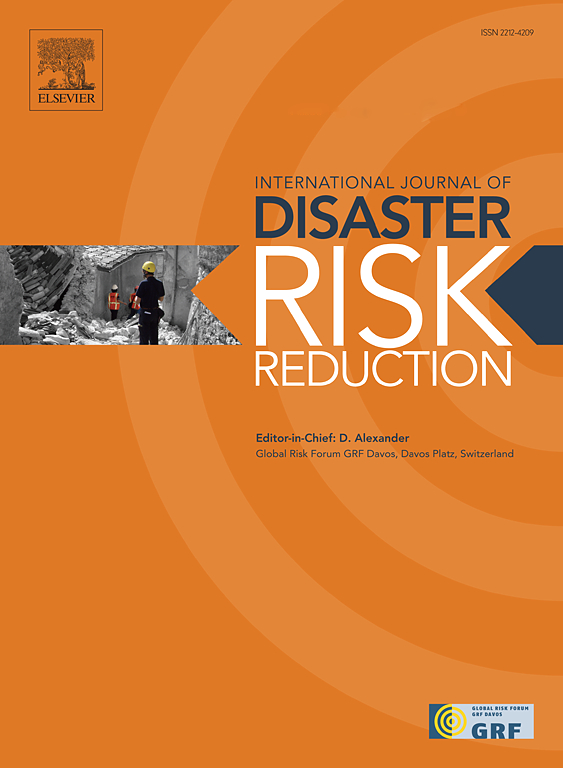On the spatiotemporal knowledge-driven vulnerability assessment of urban areas: A clustering-based approach
IF 4.5
1区 地球科学
Q1 GEOSCIENCES, MULTIDISCIPLINARY
International journal of disaster risk reduction
Pub Date : 2025-07-12
DOI:10.1016/j.ijdrr.2025.105681
引用次数: 0
Abstract
In recent years, there has been a notable increase in the implementation of emergency management digital solutions. While these systems are becoming increasingly prevalent in cities, they must be properly set up and adopted based on a comprehensive understanding of the spatiotemporal dynamics of urban areas. This study aims to develop and validate the VERUS (Vulnerability Evaluation for Resilient Urban Systems), a spatiotemporal clustering framework for assessing urban vulnerability based on the dynamic influence of urban infrastructures during emergencies, indicating how populations are negatively affected based on the existing urban dynamics. For that, a holistic and adaptive urban perspective is adopted centred on the influence of selected groups of PoTIs (Points of Temporal Influence). Moreover, instead of considering static influence, it also incorporates the fluctuating impact of each PoTI throughout time windows. The proposed clustering method divides the urban area into influence clusters to assess the vulnerabilities within their boundaries, taking as input open geospatial datasets like OpenStreetMap. To effectively address the issue of defining the optimal number of clusters, we evaluate various methods and suggest a combination of OPTICS and K-means to provide a reliable and adaptable clustering definition without the need for parameter adjustments. Experimental results in the cities of Porto, Lisbon, and Paris demonstrate its adaptability to diverse urban configurations, illustrating its practical feasibility by revealing varying levels of vulnerability. These insights emphasise its potential to inform knowledge-driven smart city systems, where tailored interventions can address the unique challenges of different urban environments.

基于聚类的时空知识驱动的城市脆弱性评价研究
近年来,应急管理数字解决方案的实施显著增加。虽然这些系统在城市中越来越普遍,但必须在全面了解城市地区时空动态的基础上适当地建立和采用它们。本研究旨在开发和验证基于城市基础设施在突发事件中动态影响的城市脆弱性时空聚类框架VERUS (Vulnerability Evaluation for Resilient Urban Systems),以表明基于现有城市动态的人口如何受到负面影响。为此,采用了一种以选定的时间影响点(PoTIs)群体的影响为中心的整体和适应性城市视角。此外,它没有考虑静态影响,而是考虑了每个poi在整个时间窗口中的波动影响。本文提出的聚类方法以OpenStreetMap等开放地理空间数据集为输入,将城市区域划分为影响集群,评估其边界内的脆弱性。为了有效地解决定义最佳聚类数量的问题,我们评估了各种方法,并建议将OPTICS和K-means相结合,以提供可靠且适应性强的聚类定义,而无需调整参数。波尔图、里斯本和巴黎等城市的实验结果证明了该方法对不同城市结构的适应性,并通过揭示不同程度的脆弱性说明了其实际可行性。这些见解强调了它为知识驱动的智慧城市系统提供信息的潜力,在智慧城市系统中,量身定制的干预措施可以解决不同城市环境的独特挑战。
本文章由计算机程序翻译,如有差异,请以英文原文为准。
求助全文
约1分钟内获得全文
求助全文
来源期刊

International journal of disaster risk reduction
GEOSCIENCES, MULTIDISCIPLINARYMETEOROLOGY-METEOROLOGY & ATMOSPHERIC SCIENCES
CiteScore
8.70
自引率
18.00%
发文量
688
审稿时长
79 days
期刊介绍:
The International Journal of Disaster Risk Reduction (IJDRR) is the journal for researchers, policymakers and practitioners across diverse disciplines: earth sciences and their implications; environmental sciences; engineering; urban studies; geography; and the social sciences. IJDRR publishes fundamental and applied research, critical reviews, policy papers and case studies with a particular focus on multi-disciplinary research that aims to reduce the impact of natural, technological, social and intentional disasters. IJDRR stimulates exchange of ideas and knowledge transfer on disaster research, mitigation, adaptation, prevention and risk reduction at all geographical scales: local, national and international.
Key topics:-
-multifaceted disaster and cascading disasters
-the development of disaster risk reduction strategies and techniques
-discussion and development of effective warning and educational systems for risk management at all levels
-disasters associated with climate change
-vulnerability analysis and vulnerability trends
-emerging risks
-resilience against disasters.
The journal particularly encourages papers that approach risk from a multi-disciplinary perspective.
 求助内容:
求助内容: 应助结果提醒方式:
应助结果提醒方式:


